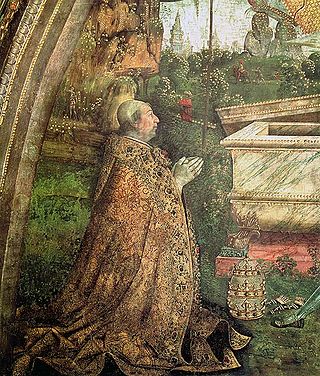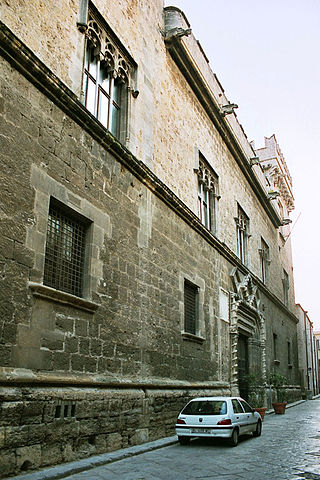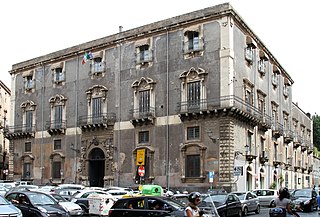
Giovanni Battista Tiepolo, also known as GiambattistaTiepolo, was an Italian painter and printmaker from the Republic of Venice who painted in the Rococo style, considered an important member of the 18th-century Venetian school. He was prolific, and worked not only in Italy, but also in Germany and Spain.

The Palazzo Pubblico is a palace in Siena, Tuscany, central Italy. Construction began in 1297 to serve as the seat of the Republic of Siena's government, which consisted of the Podestà and Council of Nine, the elected officials who performed executive functions.

The Borgia Apartments are a suite of rooms in the Apostolic Palace in the Vatican, adapted for personal use by Pope Alexander VI. In the late 15th century, he commissioned the Italian painter Bernardino di Betto (Pinturicchio) and his studio to decorate them with frescoes.

The Palazzo Beneventano del Bosco is a large urban palace, located on piazza Duomo, across from the present city hall and diagonal to the Cathedral of Syracuse, in the island of Ortigia in the city of Syracuse in Sicily, Italy.

Palazzo Abatellis is a palazzo in Palermo, Sicily, southern Italy, located in the Kalsa quarter. It is home to the Galleria Regionale della Sicilia, the Gallery of Art for the Sicilian region.



The Chinese Palace, also known as Real Casina alla Cinese, is a former royal residence of the House of Bourbon-Two Sicilies designed in the style of Chinoiserie. It is located in Palermo, inside the park of La Favorita. The Ethnographic Museum of Sicily, named after Giuseppe Pitrè, is located in one of the Palace's guesthouse.


The Palazzo dell'Università or Palazzo Centrale dell'Università di Catania is a monumental palace located in Piazza Universitaria, in the center of the city of Catania, region of Sicily, southern Italy. Since its construction, it has housed the main offices of the University of Catania, and stands across the piazza from the Palazzo San Giuliano, also housing offices of the university. It presently houses the offices of the rector, university offices, the "Giambattista Caruso" Regional Library, and a small museum of geology and archeology.

The Palazzo Manganelli is a Baroque monumental palace located in Piazza Manganelli, in the center of the city of Catania, region of Sicily, southern Italy. It is still lived in by heirs of the family, and also houses a hotel. The busy piazza serves mainly as a parking lot; at the north is a civic art gallery, housed in the former church of San Michele Minore. To the south, across Via Antonino di Sangiuliano stands the Teatro Sangiorgi. At one time, a building here housed the Istituto per la Educazione delle Fanciulle.

The Villa Cerami was once a semirural villa, located at the edge of the urban center and with a sizable surrounding garden, located at the Northern end of via Crocifero (#91), in the city of Catania, Sicily, southern Italy. Once a private home, it now houses the offices of the School of Jurisprudence (Law) of the University of Catania. It is located on a rise above the city, the villa was built atop the ruins of part of the Roman amphitheater of which some ruins are visible in nearby Piazza Stesicoro. Adjacent or nearby are three Sant'Agata churches: la Vetere, al Carcere, and alla Fornace. The route down via Crocifero passes four major Baroque churches and convents.
Santa Maria dell'Ogninella is a deconsecrated Roman Catholic church, located facing Piazza Ogninella, which lies two blocks east from the Piazza dell'Universita east along Via Euplio Reina, in the center of the city of Catania, Sicily, southern Italy. The church has undergone and still remains under restoration.

San Camillo is a Baroque, Roman Catholic parish church located in Acireale in the region of Sicily, Italy.
Santa Lucia is a Roman Catholic parish church located in Aci Catena in the region of Sicily, Italy.



The Castello Scammacca, also known as the Castello Pennisi di Floristella, is a 19th-century villa-like palace, built to resemble anachronistically a Gothic-style castle with crenellated rooflines, located on piazza Agostino Pennisi #11 (between Via dell'Agrumicoltura and Via San Girolamo, in a large plot of land in the outskirts of Acireale, Sicily, Italy. The building is privately owned, but generally unoccupied.

The Chiesa of Santissima Trinità e San Marziano is a Roman Catholic church located on via San Francesco d'Assisi, 3, just south of the town centre of Lentini, province of Syracuse, Sicily, Italy.